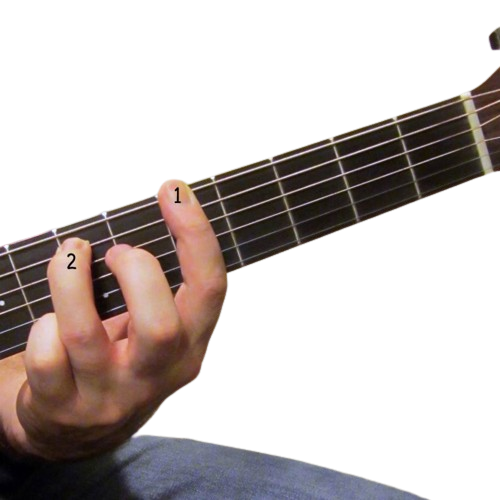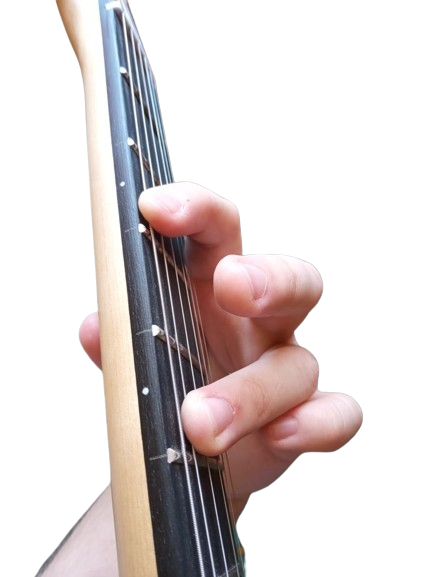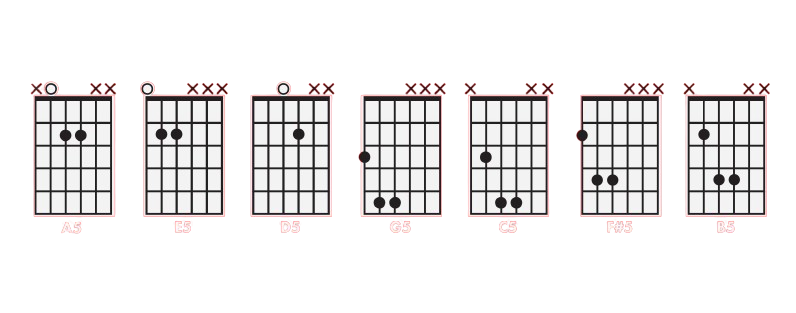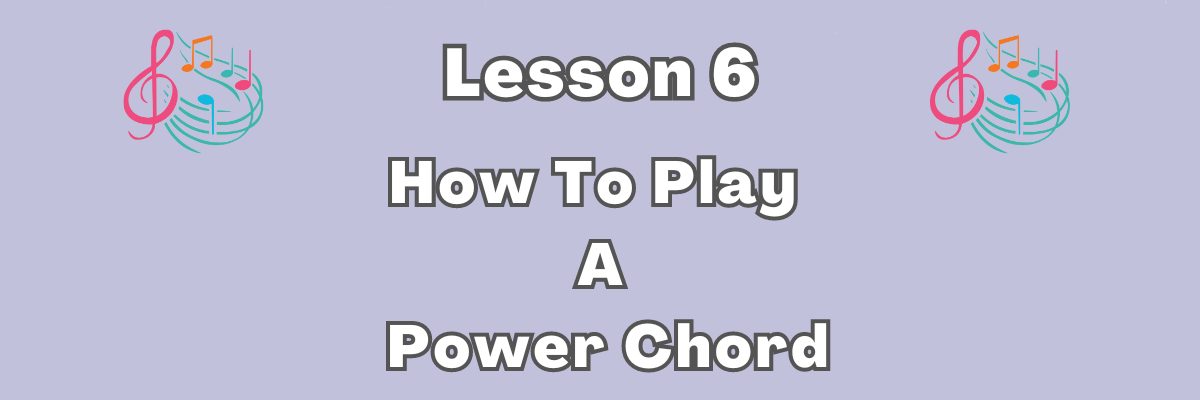How To Play A Power Chord. Are you a budding guitarist eager to unleash some rockin’ riffs? If so, then understanding power chords is a must-have skill.
Table of Contents

Hi. Ian here and welcome to this article.
Are you a budding guitarist eager to unleash some rockin’ riffs? If so, then understanding power chords is a must-have skill in your musical arsenal.
These simple yet impactful chords form the backbone of countless rock, metal, and punk songs, making them a gateway to crafting your guitar masterpieces.
What exactly is a power chord?
A power chord, also known as a fifth chord, is a guitar chord consisting of only two notes, the root note and its fifth. Unlike traditional chords that involve multiple notes, power chords offer a stripped-down, minimalist approach, yet they pack a punch that’s sure to get your audience moving.
How do I form a power chord?
The basic power chord shape is surprisingly simple. Place your first finger on the string you want the root note to be on, usually the sixth (low E) string, and press down on the third fret. Then, place your third finger on the string two frets higher, usually the fifth (low A) string. Finally, strum all the strings together, allowing them to ring out in unison.
What are the different power chord shapes?
There are multiple power chord shapes that correspond to different root notes on the guitar neck. For instance, if you move the first finger up two frets, you’ll be playing a C power chord. This means you can play power chords all over the fretboard, giving you a wide range of tonal possibilities.
What are the benefits of power chords?
Power chords are effortless to learn and play, making them a great starting point for beginners. They also sound great, providing the driving force behind many popular rock and metal songs. Plus, you can combine power chords in various ways to create complex and interesting riffs.
How can I learn more about power chords?
There are numerous resources available to help you master power chords. You can find plenty of online tutorials, guitar books, and apps dedicated to teaching this essential technique. Additionally, consider taking guitar lessons from a qualified instructor who can provide personalized guidance and feedback.
So, what are you waiting for? Grab your guitar, practice those power chords, and start rocking out to your favourite tunes!
Understanding Power Chords
Power chords are a fundamental component in various music genres, providing a simple yet impactful sound. These chords are vital for creating a solid, rhythmic foundation in rock and other heavy music styles.
Defining the Power Chord
A power chord, known technically as a “fifth chord,” consists of two different notes: the root note and the perfect fifth. Unlike traditional chords that involve three or more notes, power chords are typically comprised of just the tonic and the fifth, and sometimes the octave of the root note for added depth. For instance, if you’re playing an E power chord, you’d combine the notes E (the root) and B (the perfect fifth), with the option of adding another E (the octave).
Power Chords Vs. Major and Minor Chords
Power chords differ significantly from major and minor chords because they lack the third interval, which is what gives major and minor chords their distinct ‘happy’ or ‘sad’ qualities. The absence of this third interval means power chords are neither major nor minor; they are neutral and thus very versatile. This attribute allows you to use power chords in a vast array of songs without clashing with the song’s tonality, whether the underlying harmony implies a major chord or a minor chord.
Playing Your First Power Chord

Power chords are the backbone of many rock songs, providing a solid harmonic foundation with minimal complexity. To play your first power chord, you’ll only need to use two fingers and two notes: the root and the fifth.
Finger Placement
Start by placing your index finger on the root note of the power chord. This will usually be on the low E (6th) string of the fretboard. For instance, if you’re playing a G power chord, your index finger should be positioned on the third fret of the 6th string.
Next, place your ring finger or your third finger on the fifth, which is typically two frets up and one string down from the root. Continuing with our G power chord example, your ring finger would be on the fifth fret of the A (5th) string.
| Finger | String | Fret | Note |
|-------------|--------|------|------|
| Index Finger| 6th | 3 | G |
| Ring Finger | 5th | 5 | D |
Focus on clean finger placement, ensuring that you press down firmly near the fret, but not on it.
Strumming Techniques
When strumming guitar power chords, use only downward picks across the strings at first to get the hang of it. Strum only the strings you are fretting, which in this case are the 6th and 5th strings. Your strum should be firm and controlled to produce a strong, clear sound without hitting the other strings.
It’s essential to practice muting the other strings with the edge of your strumming hand to avoid unwanted noise. Make sure that each strum cleanly articulates both the root and the fifth notes.
As you become more comfortable, you can experiment with alternating between down and up strums to add rhythm to your playing. Remember, consistent practice is key to building muscle memory for finger placement and strumming accuracy on the fretboard.
Developing Chord Transitions

Mastering power chords involves more than just gripping the strings; it’s also about the smooth transition from one chord to another within a chord progression. Below, you’ll discover practical guidance on how to progress through chord transitions effectively.
Chord Progressions
A chord progression is a sequence of chords played in a set pattern. When playing power chords, often associated with rock music, the flow of your progression can create or release tension in a song. To establish fluidity in your transitions:
- Identify common chord progressions and practise them in different keys.
- Familiarise yourself with chord shapes and their root notes to navigate the fretboard seamlessly.
Practising with a metronome can drastically improve your timing, a key factor in playing coherent progressions.
Changing Between Chords Efficiently
Efficient chord transitions are paramount for maintaining the rhythm and drive of a song. Here’s how to change between power chords with precision:
- Practise Slowly: Begin by moving between two chords at a slow pace. Aim for accuracy over speed.
- Build Muscle Memory: Repetition is the cornerstone of muscle memory. Repeat transitions until they feel natural.
- Visualise Movements: Anticipate the next chord and visualise the finger movements before actually shifting to the next position.
- Minimise Movement: Keep your fingers close to the fretboard to reduce unnecessary motion and increase efficiency.
For more hands-on practice strategies, consider playing without looking at your fretting hand to test your muscle memory for each chord, as suggested by Guitareo Riff.
By incorporating these techniques into your practice routine, you’ll find that with time, your transitions between power chords will become quick and effortless, enriching your overall guitar-playing experience.
Exploring Power Chords on the Guitar
Power chords are a fundamental element in rock and pop music, easily identified by their full, robust sound. Due to their simplicity and versatility, they are an excellent starting point for beginners and a staple in the repertoire of experienced guitarists.
Utilising the Fretboard
Mastering power chords requires a firm understanding of the fretboard. Power chords are composed typically of the root note and the fifth interval. They are played on various string combinations, but let’s focus on the A string and D string for the C5 and G5 chords.
To form a C5 chord, press down on the third fret (G note) of the A string and combine it with the fifth fret (C note) of the D string. Your index finger should be on the A string, while your ring finger holds down the D string. This chord shape can be moved up and down the fretboard to create other power chords without changing the finger placement.
Similarly, to play a G5 chord, position your index finger on the third fret (B note) of the low E string and your ring finger on the fifth fret (D note) of the A string. Both the C5 and G5 chords can be played with the instrument in the open position, meaning no capo is needed, and you are using the first few frets of the guitar.
Here’s a simple tab to illustrate the fretboard positions for C5 and G5 power chords:
E|--------
B|--------
G|--------
D|--5---10
A|--3----8
E|--------
In this tab, the numbers represent the frets on the A and D strings – 3 and 5 for the C5 chord; move up to 8 and 10 for the G5 chord. Remember, power chords do not require the use of open chords, and they often can be played more easily since they do not use open strings.
Practising Power Chord Songs
When you learn how to master power chords on the guitar, practising songs you know and love can be a substantial motivational boost. Playing well-known tracks helps develop your technical skills and timing, opening pathways to create your own signature riffs.
Learning From Well-Known Tracks
To solidify your understanding of power chords, start by playing along to All the Small Things by Blink-182. This pop-punk classic is straightforward and exemplifies the effective use of power chords in a major hit. Another essential song to consider is Iron Man by Black Sabbath. This track offers a taste of heavy metal and is a great showcase for how power chords can underpin some of the most memorable guitar riffs in rock history.
Consider also incorporating Smells Like Teen Spirit by Nirvana into your practice. This song is a prime example of grunge, a genre where power chords play a crucial role. The driving force behind this song’s riff is a perfect way to familiarise yourself with the gritty, compelling nature of power chords.
Incorporating Techniques Into Your Own Riffs
After getting comfortable with power chords by learning existing songs, try weaving them into your own guitar riffs. Notice how The Kinks made history with their riff in You Really Got Me; use this as inspiration to experiment with rhythm and progression. As you progress, look at the works of Green Day. Their energetic punk style can inspire how you structure your riffs and transitions between chords.
By consistently practising these and other well-known songs, you’ll develop a strong repertoire of techniques. This foundation enables you to infuse elements of punk, pop, or metal into your guitar playing and encourages you to start writing riffs that could be the anchor of your iconic songs.
Further Learning and Practice
After grasping the basics of power chords, it’s pivotal to enhance your skills through a combination of structured lessons and consistent practice. Explore a variety of resources and take advantage of professional guidance to expedite your learning.
Helpful Resources
Books and Online Materials:
Begin with a chord library to familiarise yourself with different finger placements and variations of power chords. Look out for reviews to select the best learning materials.
- Video Tutorials: Platforms like YouTube offer a plethora of instructional videos which can help solidify your understanding. The How to Play Power Chords video is a great starting point.
- Online Platforms: Subscription services such as Fender Play provide structured courses and a broad range of songs to practice.
Taking Lessons
Private Tuition:
Invest in private lessons to receive personalised feedback on your technique. Your instructor can tailor sessions to your progress and style, ensuring effective learning.
- Deals and Packages: Sometimes, you can find introductory deals on lessons, especially around the holiday season or when signing up for a new service.
Remember to set aside regular time for practice. Integrating your knowledge into daily playing can lead to marked improvements in your abilities.
Power Chords Beyond Rock
While power chords are a staple in rock music, they also have a significant presence in a variety of other genres. They’re not just for rock anthems and punk aggression; power chords can add a rich, full sound in several musical landscapes.
Power Chords in Diverse Genres
Jazz: In jazz, power chords are used sparingly, often for adding a modern vibe to harmonic progressions. They’re typically employed by guitarists seeking a minimalistic texture amidst complex jazz chords.
Country: You might find power chords in modern country music, providing a driving force behind upbeat country rock tunes. While traditional country relies on open chords, power chords add a contemporary punch.
Reggae: The staccato rhythm of reggae sometimes incorporates power chords to thicken the mix, especially in modern reggae fusion genres. They’re usually played with a lighter touch, complementing the offbeat rhythmic patterns characteristic of the genre.
Metal: Heavier than rock, metal utilises power chords for their raw, aggressive tone. Metal guitarists often couple power chords with palm-muted rhythm playing to create a sense of heaviness and depth in their music.
Creative Applications of Power Chords
Songwriting: Power chords are a useful tool for songwriters across genres, offering a simple yet effective way to create a harmonic foundation. Their use can span from the centrepiece of a riff to a layer within a complex chord structure.
Arrangements: By integrating power chords into musical arrangements, you can enhance the dynamics without overwhelming other elements. They can be especially useful in building a song’s climactic sections or in adding tension to a track.
Experimentation: Power chords can be a starting point for musical experimentation. Modifying their voicings or combining them with effects such as reverb or delay can yield unique sounds that transcend their traditional use.
FAQ
Are power chords the same for electric and acoustic guitars?
Yes, the fingering for power chords is the same on both electric and acoustic guitars; however, they are more commonly used in rock music on electric guitars.
Do you need to use a specific type of guitar pick for power chords?
No, you can use any guitar pick or even your fingers, but a medium to heavy pick can provide a more solid attack.
Can power chords be played on all strings?
Power chords can be played on any string set, but are most commonly played on the lowest-pitched (E, A, and D) strings.
How do you read power chord notation?
Power chords are denoted by the root note followed by the number 5, such as C5, which is a power chord with C as the root.
Conclusion
Mastering power chords is a significant milestone in your guitar-playing journey. They are foundational in various music genres, especially rock and punk, due to their full, resonant sound. As you’ve learned, these chords consist of the root note and the fifth, sometimes with an added octave of the root to enhance the sound.
To ensure you’ve grasped the concept, remember these key points:
- Power chords are played using the root and fifth notes of a scale.
- The root note defines the chord’s name, such as C in a C5 chord.
- An octave above the root can be added for a fuller sound.
Your next steps should involve:
- Practising power chords in different positions on the fretboard.
- Experiment by incorporating them into your favourite songs.
- Building up speed and switching between chords with precision.
Remember, clear execution and consistent practice will solidify your skills. Power chords can be simple, but they’re the backbone of some of the most iconic riffs in music history. Now, armed with this knowledge, continue to expand your repertoire and enjoy the robust sound these chords add to your playing.
